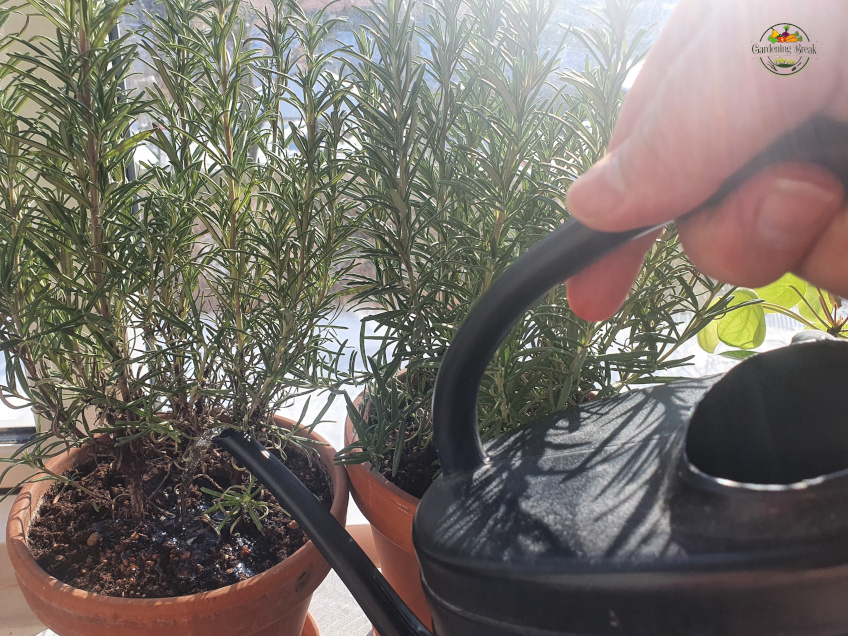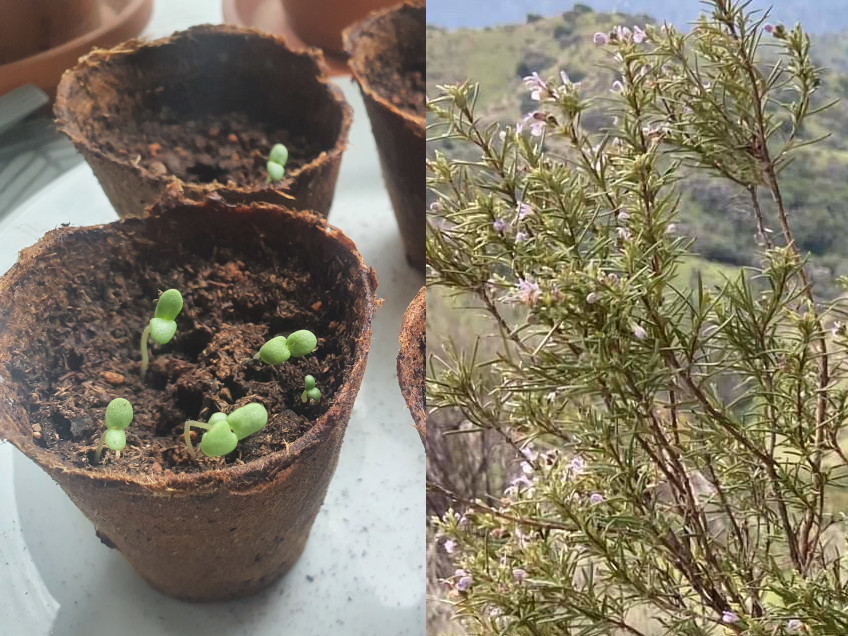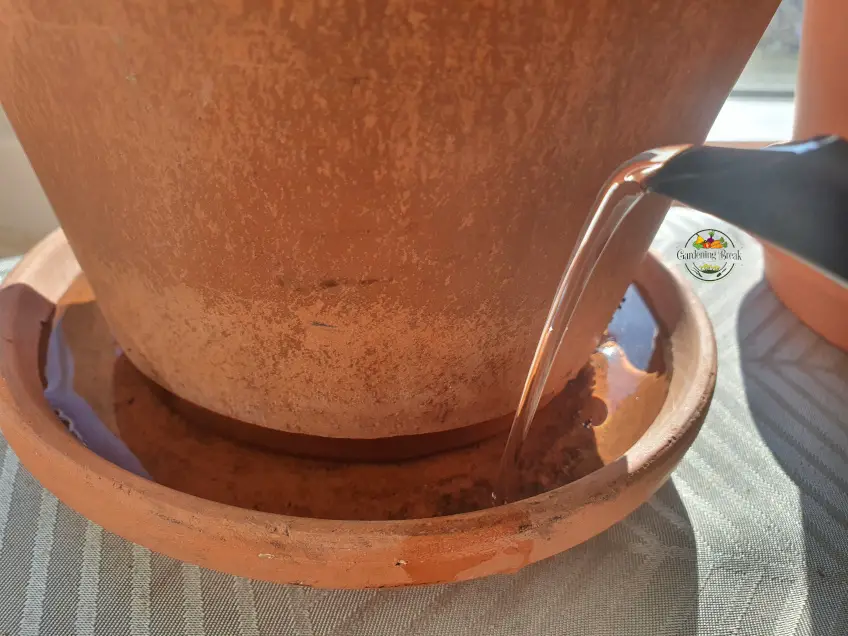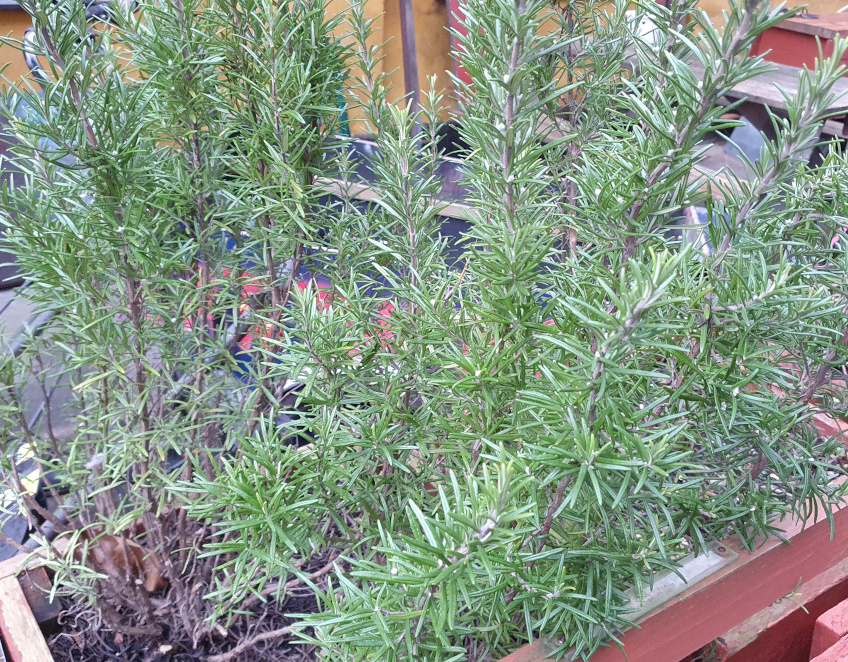
Knowing how to water rosemary correctly is crucial but since there are many ways to grow the plant and many factors that affect how often and how much water it needs, it can be challenging to get right.
I remember this being a challenge for me when I first started growing rosemary a long time ago, but now that I have a lot more experience, I know exactly how to do it.
I cover everything you need to know about how you should water your rosemary in this article. No matter how big your plant is and whether you grow it in the ground, in a pot, inside, or outside. You will learn what you need to know here.
Here is what I cover in this article:
- The best way to water your rosemary depending on how you grow it.
- How often you should water your rosemary and what factors determine it.
- How much water your specific rosemary plant needs.
- Signs that your rosemary needs to be watered.
- The best time of the day to water rosemary.
- 5 important things to avoid when watering rosemary.
Let’s get into it!
Best Way to Water Your Rosemary (Potted or in the Ground)
The most common and straightforward way to water rosemary is to just pour water onto the soil around the plant and while that generally works fine, there is often a better way to do it. It depends on how you grow it, though.
If you grow your rosemary directly in the ground, the best way to water it is to just pour the water on the soil around the plant. It is best to get as close to the soil as possible when you pour the water to avoid splashing soil onto the plant’s foliage.
I grow most of my rosemary in pots, as you can see in photos around my website, and if you do that too, there is a better way to water it and that is to water it from the bottom by pouring water into the plate underneath the pot as I do in this photo.

When you water your rosemary from the bottom like in the photo, the water is soaked up into the pot through the drainage hole.
The primary reason why bottom watering is the best way to water potted rosemary is that it encourages the roots to stretch and grow more than they would otherwise to reach the water coming in from the bottom.
This increased root growth will help the plant obtain more water and nutrients than otherwise, which makes it grow faster and better.
You can read more about why bottom-watering rosemary is so powerful and how to do it in the article on this link.
Of course, this is only possible if you grow your rosemary in a pot with drainage holes at the bottom, but I always recommend doing that. It is by far the best way to do it since pots or containers without drainage holes significantly increase the risk of overwatering, which can result in mold or even kill the plant.
I always use and recommend terra cotta pots like the ones I use in the photos in this article and around my website. The material allows excess moisture to escape through the sides of the pot, which helps provide a great environment for the roots. You can buy some great terra cotta pots from Amazon on this link.
The only disadvantage of bottom watering is that it doesn’t wash out salts and minerals from the soil so make sure to water your rosemary from the top once in a while. I do it about once a month or so and it seems to work well.
How Often to Water Rosemary Based on Size, Weather, and More
As with all other plants, there is not a single true answer as to how often rosemary needs water since several factors play a role. Luckily, I have a great rule of thumb for you that I use to figure out when I should water mine that I want to teach you.

As a general rule, potted rosemary should be watered every week and rosemary growing in the ground should be watered every two weeks. That said, many factors play a role, but I cover them for you here.
The best way to determine if rosemary needs to be watered is to look at and feel the soil. The top of the soil should dry out before you water the plant, although all of the soil should not dry out completely.
A trick I use if I am not sure is to stick a finger an inch or two into the soil. If it comes out dry, it is time to water.
You should keep the following factors in mind when determining how often to water your rosemary.
The size of the plant
Perhaps the most important factor that determines how often a rosemary plant needs to be watered is the size of the plant. Tiny, fresh rosemary seedlings need to stay in soil that is consistently moist because their roots are so tiny that they can dry out fast. Larger plants need much less frequent watering since they have a larger root system that can hold the water for longer.
A good example is the photo above where you see a couple of rosemary seedlings I am growing next to a sunny window on the left and a large, well-established plant growing outside in the Mediterranean region on the right, which my dad took a photo of for me. The seedlings need water every few days and the large plant only gets water when it rains and it still thrives.
If the plant grows in a pot or the ground
Potted rosemary usually needs to be watered more often than rosemary that grows in the ground.
This is, among other things, because potted rosemary’s roots generally don’t have access to as much water as if it grew in the ground (although this, of course, depends on the plant and the pot), but also because potting soil typically drains faster than garden soil.
I have another article where I cover this and other differences between growing rosemary in pots and in the ground. You can find it on this link.
How much sunlight the plant gets
The more sunlight plants get, the more water they use. Rosemary is no exception to this rule, so you should water it more often during warm, sunny periods, although keep in mind that it is relatively drought tolerant, so be careful not to water it too much.
How much it rains
Rain is a great, easy, and free way to water your plants. Unfortunately, it is usually not so reliable or predictable, so you have to adjust your watering based on that. The more it rains, the less you need to water your rosemary.
Of course, this is more relevant if you grow your rosemary outside, but also something to keep in mind if you grow yours indoors since more rain generally means less sunlight. You can read more about the differences between growing rosemary indoors and outside on this link.
What type of soil the plant grows in
Lastly, the type of soil your rosemary grows in plays a huge role in how often you need to water it. This is because some soil types drain very quickly and others very slowly. Soil with a high sand content generally drains much faster than soil with a higher content of clay, for example.
Rosemary should grow in light, well-draining, sandy soil since poor-draining soil can result in damage to the roots since the water stays for too long.
How to Give Your Rosemary the Correct Amount of Water
Figuring out precisely how much water your rosemary plant needs can be tricky since all the factors I listed above play a role and several of them are environmental factors that change all the time. That said, this is what I usually do.

I grow most of my rosemary plants in 8-12 inches (20-30 cm) wide pots and for those, I usually give them about 1-2 cups (a bit less than 2.5-5 dl) of water every time I water them. While this is a good rule of thumb, you should keep the many factors that affect it in mind.
Instead of giving your rosemary a specific amount of water, it is much more reliable to know what signs the plant shows when it needs water. Keep in mind that it tolerates drought much better than most other herbs, so it is okay to wait for these signs, although you should not wait longer than that.
With some practice and experience, you get a really good feeling of when the plant needs water and you can water it before these signs appear while still not overwatering it.
I cover the signs rosemary plants show when they need water now.
How to Tell if Your Rosemary Needs Water (4 Clear Signs)
To avoid watering-related problems such as overwatering and underwatering, it is important to know how to tell if a rosemary plant needs water. I have observed four signs to look out for, that I want to share with you.
The four signs that rosemary needs water are:
- The top few inches of the soil are dry.
- Leaves begin to dry out.
- Leaves turn brown.
- The pot feels light when you lift it.
It is important to remember that some of these signs, particularly those related to the leaves, also can appear as a result of overwatering. If you are not sure if your rosemary is getting too much or too little water, you should check the soil. The top inch or two should be dry before you water.
Best Time of the Day to Water Rosemary for Better Growth
While it is not the most crucial thing when it comes to watering rosemary, choosing the right time of the day to do it can still make a significant difference in how well it grows and can actually also reduce the risk of a bunch of problems.

The best time of the day to water rosemary is early in the morning. This is because the plant uses much more water when there is sunlight, so watering it early allows it to have the water it needs throughout the day.
Watering in the evening can be necessary but it comes with some risks. For example, it can cause the water to stay in the soil around the roots for a long time since the plant doesn’t use much when there is no sunlight.
Sometimes when you water your plants, some water splashes onto the leaves, which can increase the risk of fungal diseases and other issues. The risk of this is also significantly lower if you water in the morning since the plant has time to dry off during the day when there is sunlight.
That said, it is always better to water your rosemary if it needs water, regardless of what time it is. I like to sleep in sometimes, which means I can’t always water my plants in the morning. While it is not always optimal, it is always better to water plants that need water than to neglect them.
5 Important Things to Avoid When Watering Rosemary
So far in this article, I have covered all the things you should do when you water your rosemary, but there is also a handful of things you should do your best to avoid.
Avoiding these things can help you avoid a lot of different problems. If you do happen to have some problems with your rosemary plants right now and aren’t sure what to do, I recommend that you head over to the article on this link, where I cover the 12 most common ones and explain how to solve them.
Here are five things you should always avoid when growing rosemary.
Avoid overwatering your rosemary
Overwatering is one of the most common mistakes people make when they grow rosemary. I certainly also did it a few times when I started growing it. The best trick I have found is to keep an eye on the soil, as I have explained in this article. Make sure the top few inches dry out before you water the plant again.
I recommend heading over to the article on this link, where I share everything you need to know about how to tell if rosemary is overwatered, what to do about it, and how to avoid it.
Avoid underwatering your rosemary
Watering rosemary requires that you find a good balance because just like overwatering can kill a plant, underwatering can be just as destructive. While underwatering is a less common problem with rosemary, it should absolutely still be kept in mind and avoided. I shared four signs earlier in this article that you should look out for to avoid underwatering.
Avoid splashing water and soil onto the foliage when you water your rosemary
It is very common that people just pour water all over their rosemary plants when they water them. While that seems like a natural way to do it, it is actually not recommended. This is mostly because it can cause water and soil to splash onto the foliage, which increases the risk of fungal diseases.
Instead of watering that way, pour the water onto the soil from a short distance to avoid splashing or water your rosemary from the bottom if it grows in a pot with a drainage hole, as I explained earlier in this article.
Avoid watering your rosemary with too high pressure
If you water your plants with a hose, you can often control the water pressure. It may seem tempting to use high pressure to get the job done faster, but I don’t recommend doing that since it can damage the foliage and the roots. Instead, be more gentle and water with lower pressure.
Avoid watering your rosemary in the evening when possible.
It is always best to water rosemary early in the morning since the plant needs water throughout the day when there is sunlight. Watering in the evening can be fine if the plant is heavily underwatered and needs water as soon as possible, but should be avoided otherwise.
As I explained a bit earlier in this article, this is because the water stays in the ground around the roots for longer when there is no sunlight, which can end up damaging them.

